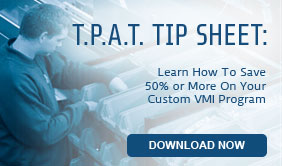 The motivation behind implementing a vendor managed inventory (VMI) program is to streamline your supply chain in ways that ultimately save you space, time and money (in labor, inventory, energy). But too often we see VMI programs that aren’t focused explicitly enough on directly accomplishing these things.
The motivation behind implementing a vendor managed inventory (VMI) program is to streamline your supply chain in ways that ultimately save you space, time and money (in labor, inventory, energy). But too often we see VMI programs that aren’t focused explicitly enough on directly accomplishing these things.
The best VMI programs are aligned with – and contribute to – an organization’s overall Lean journey and consider where the organization is on the journey.
We’re going to take a look at what Lean means in the context of a VMI program and how to determine if your program aligns with those principles. Because if it’s not, it’s not working as hard for you as it can and should.
What Is Lean?
"Lean" was first used to describe Toyota's approach to business process improvement during the late 1980s as they sought to maximize value to customers through a value creation process that has zero waste.
Toyota and other lean practitioners start by understanding where the value is to customers, then focus their processes on continuously increasing the value they deliver while remaining vigilant at creating value streams without waste.
In order to do that, lean companies optimize the flow of products and services through all processes and include not just actual manufacturing floor activities, but those associated with technology, assets, and all cost and activity centers.
Eliminating waste throughout the process, instead of just at isolated points, creates workflows that require less labor, less brick and mortar, less invested capital, and less throughput time, to deliver products at lower costs and with fewer defects.
In a manufacturing environment, the corporate supply chain represents the greatest opportunity for streamlining and eliminating waste in the organization. A custom VMI program should demonstrate alignment with all 5 Lean principles in order to fulfill its potential of being the single greatest contributor to advancement in the Lean journey.
Lean Principles
- Identify customers and specify value. Define the value of a specific product from the end customer’s perspective so all the non-value activities, or waste, can be targeted for removal
- Map the value stream. The value stream is the set of activities across all parts of the organization involved in delivering the customer value, which in manufacturing is represented by quality products delivered on time and performing as promised and/or specified by the customer.
- Create flow by eliminating waste. Often, when a value stream is mapped, you see that not all of the associated activities actually add value. Eliminating waste means minimizing cost and optimizing throughput, benefiting both supplier and customer.
- Respond to customer pull. When you understand the customer demand you can create a process that aligns with and responds to it, with the goal of producing only what the customer wants when the customer wants it
- Pursue perfection. Creating flow and pull starts with reorganizing each individual process step, then linking those steps together. As this happens, more and more layers of waste become visible which can be eliminated as the process continues towards full optimization
Supply Technologies approach to supply chain management, Total Supply Management™, is an approach engineered to fully optimize customers’ supply chain operations by aligning with Lean practices and contributing to positive impact on the organization. We eliminate non-value-added activities and non-value-added fixed costs, helping customers stay profitable and competitive, and often improving the quality of their product.
To do that, we map, analyze and optimize customers’ hard and soft costs across these 7 key areas of the supply chain:
- Logistics
- Global sourcing
- Custom program development
- Implementation
- Quality assurance
- Engineering efficiencies
- Advanced technology
In the process, we apply a number of proven methods for change and improvement, including Plan-Do-Check-Act (PDCA), Kaizen, and Business Process Improvement (BPI) practices. Some of the methods being executed with current customers include:
- Minimizing the footprint of supplies at customer sites by increasing overall flow efficiency and use of Kanban and other “pull” processes
- Placing product in the “strike zone” to increase operator productivity and ergonomics
- Using data for problem identification and determining root causes (5Whys)
- Implementing and sustaining Visual management/5S (sort, straighten, sustain, standardize, shine)
- The standardization of processes, relevant metrics and communication between all employees at all levels enhances our ability to provide fast response to our customers’ changing demands
From our experiences we’ve learned many VMI programs fall far short of the value that Lean inspires, by focusing too much on the practices and processes that seem most reasonable to the supplier, without fully considering the impact or possibilities to enhance the customers’ value stream. We’ve focused the methodology of our Tactical Process Analysis Team (T.P.A.T.) on a foundation that starts with the five Lean principles, and in the process we’ve learned that building VMI programs on Lean foundations leads to results that makes customers and their customers very satisfied. Let us know if you’re interested in getting starting on a satisfying Lean VMI journey.



